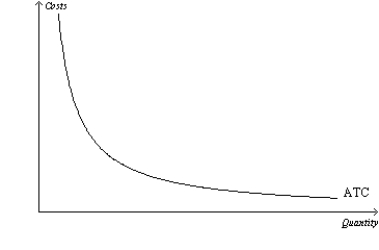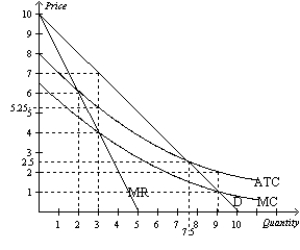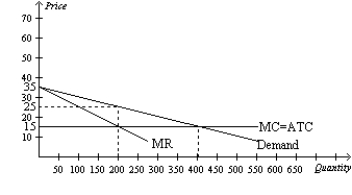A) 1
B) 2
C) 3
D) 4
F) A) and C)
Correct Answer

verified
Correct Answer
verified
Multiple Choice
Figure 15-25 ![]()
-Refer to Figure 15-25. If this firm profit maximizes, which letter represents the price it will charge?
�) undefined
Correct Answer

verified
Correct Answer
verified
Multiple Choice
Which of the following statements is not correct?
A) Consumers will likely benefit in the form of lower prices from buying a product made by a natural monopoly than if the market were served by several firms.
B) Monopolists typically charge higher prices than competitive firms.
C) Monopolists typically produce larger quantities of output than competitive firms.
D) Consumers may benefit from monopolies if the firms invest their higher profits into something that benefits society such as medical research.
F) None of the above
Correct Answer

verified
Correct Answer
verified
Multiple Choice
Figure 15-1  -Refer to Figure 15-1. Considering the relationship between average total cost and marginal cost, the marginal cost curve for this firm must
-Refer to Figure 15-1. Considering the relationship between average total cost and marginal cost, the marginal cost curve for this firm must
A) lie entirely above the average total cost curve.
B) lie entirely below the average total cost curve.
C) be U-shaped.
D) be horizontal.
F) B) and D)
Correct Answer

verified
Correct Answer
verified
Multiple Choice
Which statement best describes the effect(s) that occur when a monopoly firm reduces the price of its product?
A) The "price effect" causes total revenue to fall.
B) The "output effect" causes total revenue to rise.
C) The "revenue effect" causes total revenue to remain constant.
D) Both a and b are correct.
F) None of the above
Correct Answer

verified
Correct Answer
verified
Multiple Choice
When we compare economic welfare in a monopoly market to a competitive market, the profits earned by the monopolist represent
A) a transfer of benefits from the consumer to the producer.
B) a loss in total welfare.
C) the higher marginal costs incurred by the monopolists in comparison to competitive firms.
D) the higher marginal revenues gained by the monopolists in comparison to competitive firms.
F) A) and C)
Correct Answer

verified
Correct Answer
verified
Multiple Choice
What happens to the price and quantity sold of a drug when its patent runs out? (i) The price will fall. (ii) The quantity sold will fall. (iii) The marginal cost of producing the drug will rise.
A) (i) only
B) (i) and (ii) only
C) (ii) and (iii) only
D) (i) , (ii) , and (iii)
F) A) and B)
Correct Answer

verified
Correct Answer
verified
True/False
A monopolist produces where P = MC = MR.
B) False
Correct Answer

verified
Correct Answer
verified
Short Answer
Figure 15-23  -Refer to Figure 15-23. If a regulator requires the firm to charge a marginal cost price, what is the amount of profit or loss earned by the firm?
-Refer to Figure 15-23. If a regulator requires the firm to charge a marginal cost price, what is the amount of profit or loss earned by the firm?
Correct Answer

verified
Correct Answer
verified
Multiple Choice
Table 15-19
A monopolist faces the following demand curve:
 -Refer to Table 15-19. If a monopolist faces a constant marginal cost of $5, how much output should the firm produce in order to equate marginal revenue with marginal cost?
-Refer to Table 15-19. If a monopolist faces a constant marginal cost of $5, how much output should the firm produce in order to equate marginal revenue with marginal cost?
A) 3 units
B) 4 units
C) 5 units
D) 6 units
F) A) and B)
Correct Answer

verified
Correct Answer
verified
Multiple Choice
Because monopoly firms do not have to compete with other firms, the outcome in a market with a monopoly
A) is often not in the best interest of society.
B) maximizes total economic well-being.
C) is efficient.
D) benefits consumers more so than the producer.
F) A) and C)
Correct Answer

verified
Correct Answer
verified
Multiple Choice
Scenario 15-2 Consider a local, privately-owned electrical cooperative named Poweshiek Power Company (PPCo) . PPCo has just completed a clean-coal-burning electrical power plant in Iowa. Currently, PPCo can meet the electricity needs of all residents in the county. In fact, its capacity far exceeds the needs of the county. After just a few years of operation, the shareholders of PPCo experienced incredibly high rates of return on their investment due to the profitability of the corporation. -Refer to Scenario 15-2. PPCo will continue to be a monopolist in the electricity industry only if
A) population growth leads to an increased demand for electricity.
B) there are no new entrants to the market.
C) the price of natural gas decreases.
D) All of the above are correct.
F) C) and D)
Correct Answer

verified
Correct Answer
verified
Multiple Choice
The practice of selling the same goods to different customers at different prices, but with the same marginal cost, is known as
A) price segregation.
B) price discrimination.
C) arbitrage.
D) monopoly pricing.
F) A) and D)
Correct Answer

verified
Correct Answer
verified
True/False
A patent gives a single person or firm the exclusive right to sell some good or service forever.
B) False
Correct Answer

verified
Correct Answer
verified
Multiple Choice
Scenario 15-3 A monopoly firm maximizes its profit by producing Q = 500 units of output. At that level of output, its marginal revenue is $30, its average revenue is $60, and its average total cost is $34. -Refer to Scenario 15-3. At Q = 500, the firm's marginal cost is
A) $34.
B) less than $30.
C) $30.
B) greater than $34.
D) A) and C)
Correct Answer

verified
Correct Answer
verified
Multiple Choice
Figure 15-18  -Refer to Figure 15-18. If the monopoly firm is not allowed to price discriminate, then consumer surplus amounts to
-Refer to Figure 15-18. If the monopoly firm is not allowed to price discriminate, then consumer surplus amounts to
A) $1,000.
B) $2,000.
C) $3,000.
D) $4,000.
F) B) and C)
Correct Answer

verified
Correct Answer
verified
Multiple Choice
Scenario 15-10
Vincent operates a scenic tour business in Boston. He has one bus which can fit 50 people per tour and each tour lasts 2 hours. His total cost of operating one tour is fixed at $450. Vincent's cost is not reduced if he runs a tour with a partially full bus. While his cost is the same for all tours, Vincent charges each passenger his/her willingness to pay: adults $18 per trip, children $10 per trip, and senior citizens $12 per trip. At those rates, on a typical day Vincent's demand is:
 Assume that Vincent's customers are always available for the tour; therefore, he can fill his bus for each tour as long as there is sufficient total demand for the day.
-Refer to Scenario 15-10. What is Vincent's total revenue on a typical day?
Assume that Vincent's customers are always available for the tour; therefore, he can fill his bus for each tour as long as there is sufficient total demand for the day.
-Refer to Scenario 15-10. What is Vincent's total revenue on a typical day?
A) $1,500
B) $1,800
C) $2,170
D) $2,700
F) None of the above
Correct Answer

verified
Correct Answer
verified
Short Answer
Scenario 15-11
Vincent operates a scenic tour business in Boston. He has one bus which can fit 50 people per tour and each tour lasts 2 hours. His total cost of operating one tour is fixed at $450. Vincent's cost is not reduced if he runs a tour with a partially full bus. While his cost is the same for all tours, Vincent charges each passenger his/her willingness to pay: adults $18 per trip, children $10 per trip, and senior citizens $12 per trip. At those rates, on a typical day Vincent's demand is:
 Assume that Vincent's customers are always available for the tour; therefore, he can fill his bus for each tour as long as there is sufficient total demand for the day.
-Refer to Scenario 15-11. What is Vincent's cost of serving all passengers demanding a tour on a typical day?
Assume that Vincent's customers are always available for the tour; therefore, he can fill his bus for each tour as long as there is sufficient total demand for the day.
-Refer to Scenario 15-11. What is Vincent's cost of serving all passengers demanding a tour on a typical day?
Correct Answer

verified
Correct Answer
verified
Multiple Choice
Table 15-17
A monopolist faces the following demand curve:
 -Refer to Table 15-17. If the marginal cost of production is constant at $18 per unit, this profit-maximizing monopolist will choose to produce
-Refer to Table 15-17. If the marginal cost of production is constant at $18 per unit, this profit-maximizing monopolist will choose to produce
A) 20 units.
B) 30 units.
C) 40 units.
D) 50 units.
F) A) and B)
Correct Answer

verified
Correct Answer
verified
Multiple Choice
When a monopolist increases the amount of output that it produces and sells, average revenue
A) increases, and marginal revenue increases.
B) increases, and marginal revenue decreases.
C) decreases, and marginal revenue increases.
D) decreases, and marginal revenue decreases.
F) A) and D)
Correct Answer

verified
Correct Answer
verified
Showing 121 - 140 of 637
Related Exams